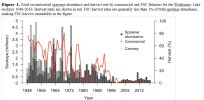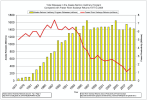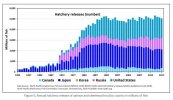Great post & questions, SF. Thanks for them and your rational, respectful approach.
IMHO - yes there has been some improvements
IN SPITE OF resistance and collusion/corruption between the regulators/protectors and those in stead focused on the protection of wild stocks.
I clearly remember the resistance and lies promoted by DFO and industry (hard to tell whom is speaking on whom's behalf sometimes as they crib & share speaking notes) when the impacts of sea lice came up about ~20 year ago now. It took independent, outside researchers to develop an understanding of background levels of sea lice and many years of politics to develop a response to those impacts -
NOT again due to the industry being responsible - or being forced to by DFO.
So now at least we look @ sea lice levels to some extent (on farm, mostly), but have inadequate triggers and enforcement in the Conditions of Licence.
I see history repeating itself in the industry's response to the issue of disease transfer and impacts to wild stocks - the same denials, resistance, lies, and shooting the messenger.
Other jurisdictions (esp. Norway) are far, far ahead in admitting and responding to those rather obvious impacts - but as can be seen from reading the pages in this thread - the industry pundits in Canada are still stuck in denials because frankly - big money is involved. That greases many palms, as well as providing income to the industry workers and pay outs to the the shareholders.
The industry gets free pumping, free sewerage disposal and nearly free real estate using the open net-pen technology - which is where I have an issue with this industry and how it operates. There is no incentive to go to closed containment when these impacts and expenses are externalized to the environment and the adjacent wild stocks.
Can we minimize these impacts to some extent - yes. And that was Cohen's recommendations was about and why the industry was booted out of the Discovery Islands areas amidst much wailing by the industry that has grown far too use to getting their way by anyways necessary (I have seen much of DFO over the years and read many ATIPS and I am in firm belief that it is VERY corrupt on the top end). That history of backroom deals with the regulators has been ongoing since the province ran the show:
The Globe and Mail offers the most authoritative news in Canada, featuring national and international news

www.theglobeandmail.com
But one cannot truly or fully mitigate impacts to wild stocks because the water flows freely in and out of the pens using the OPEN net-pens. That technology has not really changed. Yes, they have switched to more effective upgrades in the productions end of things (stronger cages, better feeding regimes wasting less feed, etc.) - but the same wild-cultured stock interactions happen - and frankly I am concerned about the wild stocks - not the industry's profit margins.
I am supportive of any and all changes that help the wild stocks - but until the industry goes full closed containment - I am convinced impacts will continue.

















